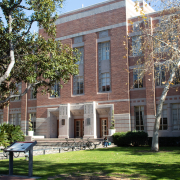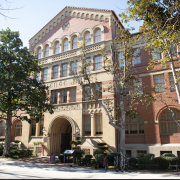I’m a first-generation, low-income student from Illinois. For people like me, the future is bleak.
By FAITH SAN MARTIN

(Lyndzi Ramos | Daily Trojan)
Soon after John F. Kennedy’s famous 1961 executive order instructing government contractors to take “affirmative action to ensure that applicants are employed, and that employees are treated during employment, without regard to their race, creed, color, or national origin,” institutions of higher education followed suit. USC quickly incorporated the policies, which aimed to ensure a race-conscious and need-blind admissions process. In 2020, the University also began offering full-tuition waivers for admitted students whose families earn $80,000 a year or less. The University now boasts one of the most diverse student bodies in the nation: Students of color comprise 43% of the student population; women outnumber men by almost 3,600.
I am a first-generation, low-income college student from a small suburban community in Illinois. Affirmative action was not the reason why I was admitted to USC, but it allowed the University to see through my personal obstacles in the college admissions process, including the knowledge of prestigious universities in the first place as well as limited SAT preparation. It also helped me afford to attend my dream college, because the initiative to help high-achieving low-income students like me encouraged USC to give me free tuition and additional financial aid, which approximately gave me a full ride to the University.
With affirmative action now shut down following the Supreme Court’s 6-3 vote June 29 to declare it unconstitutional, future generations of students, especially those with backgrounds like mine, will be the ones to suffer the consequences.
I have moved more times in my life than I can count on my fingers, and I come from a line of immigrants who did their best to give me a better life. My high school counselor encouraged me to attend Illinois State University. Perhaps she understood that, despite my strong academic record, the odds were stacked against me. I couldn’t afford to enroll in community college courses, as my peers had. I couldn’t afford an SAT tutor or to take the exam multiple times, as my peers had. My financial status prevented me from attaining those achievements: the extra credits and the high test scores that were supposedly objective metrics used in the admissions process.
Attending ISU probably wouldn’t have been so bad, but if it wasn’t for USC’s affirmative action policy — and endless Googling on my part to find USC in the first place — I would have never known what I was capable of. The odds were still low, but affirmative action gave me the confidence to at least try. And, in the end, it worked: I was one out of only three seniors in my class to attend a prestigious university.
With race-conscious admissions now repealed across the country, the next generation of college applicants won’t have that same confidence and fortune that I did. We’ve already seen it here in California, where affirmative action has been banned in public schools since 1996: UC schools suffered a sharp drop in diversity for the class of 1998, which discouraged Black and Latine students from even applying to those colleges, according to a 2020 study by Princeton University economist Zachary Bleemer.
Alternatives to explicitly considering race as a factor, explored and documented in the nine states that had banned affirmative action prior to the Supreme Court ruling, aren’t much better. Guaranteeing admission for a percentage of graduates per high school, another method colleges have tried, only works if the high schools themselves are majority-Black or Latine.
What opponents of affirmative action refuse to recognize is that affirmative action was never an advantage for students of marginalized identities — white women are the policies’ greatest benefactors, attaining high-paying positions or other advances that would not have been possible without affirmative action. Not to mention, the Supreme Court decision doesn’t even apply to legacy admissions, which is, in and of itself, a form of affirmative action for the privileged.
It is also insulting to assume that the only reason people that look like me and others, who overcame systemic disadvantages, were even accepted into top universities like USC is because of our racial and ethnic backgrounds.
Somehow, affirmative action is often used as a reason for white people to fight for their “well-deserved spot” when they are not accepted. In 2016, for example, a white woman, Abigail Fisher, sued the University of Texas at Austin when she was rejected by the highly selective institution. UT Austin’s policy was to admit all in-state students who graduated in the top 10% of their classes, then consider race as a factor for the remainder of applicants. Fisher, who graduated with a 3.59 GPA and 1180 SAT, spent the next seven years in court arguing that students of color who were less qualified than herself were allowed in because of UT Austin’s race-conscious policies.
The Supreme Court eventually ruled, in Fisher v. University of Texas, that UT Austin’s policies were constitutional; nonetheless, such a sentiment blatantly ignores that students of color, like myself, worked just as hard to get to where we are. (Never mind that, the year Fisher applied, UT Austin had rejected 168 Black and Latine students with better scores than her; one Black student, four Latine students and 42 white students with lower scores were accepted.) Affirmative action was hardly a privilege; it was, at least, an attempt at compensating for the systemic disadvantages we face precisely because of our “racial backgrounds.”
With race-conscious admissions now repealed across the country, the next generation of college applicants won’t have that same confidence and fortune that I did.
Of course, it was hardly perfect. USC may fare better in terms of diversity compared to other institutions, but imposter syndrome still persists. In most of my legal interest classes at USC, I often found myself as the only Latina student in the lecture hall. I found it painfully difficult to feel like I belonged in a place where no one looked like me. There are, of course, various centers and student organizations where I found the support and community I needed: the Latinx/Chicanx Center for Advocacy and Student Affairs, the First Generation Plus Success Center and Kappa Delta Chi, a Latine-interest multicultural sorority.
But the fact remains that diversity in the classroom is still low — and that was when affirmative action was legal.
Now that the policy is gone, students who not only endured the same obstacles I did but those who will soon experience their college acceptance experiences are lost, unsure of what will happen next. We hope for the best but fear the worst.
We can only hope that this decision made by the Supreme Court does not hurt the next generation, and that institutions, including USC, go beyond merely making statements about pursuing diversity by creating policies that let Black, Indigenous and people of color communities know they are being heard and seen.
The road is not easy, but we will continue to show others and ourselves that we deserve to be here and that we will keep fighting for a fair college admissions process — for our generation and the next. ❋
Faith San Martin is a staff writer for the Daily Trojan. She is a rising junior majoring in political science and government.










